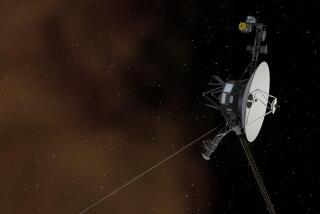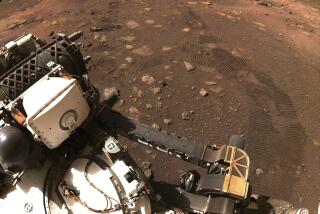As Curiosity’s big Mars moment nears, new glitch adds new stress
NASA has less than three weeks before the space agency tries to land the Curiosity rover on Mars, but there’s still time for problems.
Just as scientists attempt to pinpoint a landing on alien soil from millions and millions of miles away, a wrench has been thrown in the works.
This was the plan: Have the Odyssey spacecraft, now making its way around the Red Planet, sync up with sister spacecraft the Mars Reconnaissance Orbiter. The craft would align above the landing site, just as the rover was making its tricky landing in Mars’ Gale Crater.
But it looks as if technical problems may have put the kibosh on that great plan.
INTERACTIVE: From liftoff to landing
If it had worked, Odyssey would have helped relay important information on the descent and landing of Curiosity -- and even to capture an image of the rover, hooked to its supersonic parachute, barreling toward the topsoil.
But Ashwin Vasavada, deputy project director of the Mars Science Laboratory, said in an interview Monday with the Los Angeles Times that a few weeks ago the Odyssey developed a problem with an instrument used to orient the satellite.
“This interrupted the plan to sync up with Curiosity’s entry,” Vasavada said.
NASA made one attempt to re-sync Odyssey, which failed, he said; the agency is now considering whether to give it another try.
But, Vasavada stressed, this new hiccup won’t affect the safety of the rover landing.
“It just affects how soon the team knows that Curiosity has touched down successfully,” he said.
The development adds new stress to what was already a nail-biting moment.
The Mars Science Laboratory is now on its way to Mars for an Aug. 5 landing. When it hits the atmosphere of the Red Planet, it will have to slow from a speed of 13,000 mph using a heat shield. A parachute is set to open to further slow the descent while the craft is still moving faster than the speed of sound. The Curiosity rover will then be lowered to the ground using rockets and tethers.
“People always ask me why land in such a crazy way — and believe me, at first glance, it seems crazy to all of us too,” Vasavada said in an earlier interview with The Times.
With Curiosity, though, NASA has two important innovations, the scientist said -- “our ability to steer through the atmosphere to correct for imperfect aim and weather, and the sky crane, the rocket-powered ‘jetpack’ that sets the rover down on the surface.”
Obstacles may be thrown in Curiosity’s path. But, as Vasavada said, the missions are about “engineering solutions to accomplish scientific exploration.”
ALSO:
Human colony on Mars and a reality show to boot
Mars ‘Terror’ video may leave you thinking: Not going to work
Low rainfall and parched soil? Those may be signs of impending heat wave
Join Amy Hubbard on Google+. Email: [email protected]
More to Read
Sign up for Essential California
The most important California stories and recommendations in your inbox every morning.
You may occasionally receive promotional content from the Los Angeles Times.









